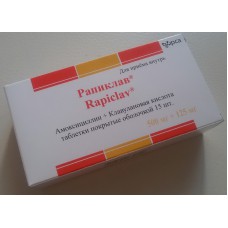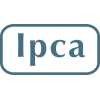Expiration date: 12/2026
Form of issue and composition:
Tablets, coated from white to almost white, oval.
1 tablet contains:
amoxicillin (trihydrate) 250 mg
clavulanic acid (in the form of potassium salt) 125 mg
Auxiliary substances: silicon dioxide colloidal, microcrystalline cellulose, sodium croscarmellose, magnesium stearate, hypromellose, dibutyl phthalate, talc purified, titanium dioxide, isopropanol, methylene chloride.
3 PCs. - blisters (5) - packs cardboard.
3 PCs. - blisters (7) - packs cardboard.
3 PCs. - strips (7) - packs cardboard.
3 PCs. - strips (5) - packs cardboard.
21 PCs. - bottles of dark glass (1) - packs cardboard.
Tablets, coated from white to almost white, oval.
1 tablet contains:
amoxicillin (trihydrate) 500 mg
clavulanic acid (in the form of potassium salt) 125 mg
Auxiliary substances: silicon dioxide colloidal, microcrystalline cellulose, sodium croscarmellose, magnesium stearate, hypromellose, dibutyl phthalate, talc purified, titanium dioxide, isopropanol, methylene chloride.
3 PCs. - blisters (5) - packs cardboard.
3 PCs. - blisters (7) - packs cardboard.
3 PCs. - strips (5) - packs cardboard.
3 PCs. - strips (7) - packs cardboard.
21 PCs. - bottles of dark glass (1) - packs cardboard.
Pharmacological action:
Antibacterial drug is a combination of amoxicillin-semi-synthetic penicillin with a wide range of antibacterial activity and clavulanic acid - irreversible inhibitor beta-lactamase (II, III, IV, V type in relation to type I inactive). Clavulanic acid forms a stable inactivated complex with these enzymes and prevents the loss of antibacterial activity of amoxicillin caused by the production of beta-lactamase as the main pathogens and co-pathogens and opportunistic microorganisms. This combination provides high bactericidal activity of Rapiclav.
The drug has a wide range of antibacterial action. Active against sensitive and amoxicillin-producing beta-lactamase strains of gram-positive aerobes: Streptcccus pneumniae, Streptcccus pygenes, Streptcccus viridans, Streptcccus bvis, Staphycccus aureus (except methicillin-resistant strains), Staphycccus epidermidis (except methicillin-resistant strains), Listeria spp., Entercccus spp. gram-negative aerobes: Brdetea pertussis, Brucea spp., Campybacter jejuni, Escherichia ci, Gardnerea vaginais, Haemphius infuenae, Haemphius ducreyi, Kebsiea spp., Mraxea catarrhais, gnrrheae Neisseria gonorrhoeae, Neisseria meningitidis, Pasteurea mutcida, Prteus spp., Samnea spp., Shigea spp., Vibricherae, Yersenia entercitica of anaerobes: Peptcccus spp., Peptstreptcccus spp., Cstridium spp., Bacterides spp., Actinimyces israei.
Pharmacokinetics:
The main pharmacokinetic parameters amoxicillin and clavulanic acid are similar.
Suction
Both components are well absorbed from the gastrointestinal tract after ingestion, eating does not affect the degree of absorption. Cmax of active substances in plasma are determined approximately 1 h after ingestion.
Distribution
Both components are characterized by good Vd and distributed in the body fluids and tissues (including the lungs, middle ear, pleural and peritoneal fluid, uterus, ovaries). Amoxicillin also penetrates the synovial fluid, liver, prostate gland, Palatine tonsils, muscle, gall bladder, the secret of the sinuses, saliva and bronchial secret.
Amoxicillin and clavulanic acid do not penetrate the BBB at unhealed meninges, but penetrate the placental barrier and are excreted with breast milk in trace concentrations.
Plasma protein binding in amoxicillin and clavulanic acid is low.
Metabolism
Amoxicillin is partially metabolised, clavulanic acid is, apparently, an intense metabolism.
Breeding
Amoxicillin is excreted by the kidneys almost unchanged by tubular secretion and glomerular filtration. Clavulanic acid is eliminated by glomerular filtration and partly in the form of metabolites. Small amounts can be excreted through the intestines and lungs. T1 / 2 amoxicillin and clavulanic acid is 1-1.5 hours.
Pharmacokinetics in special clinical situations
In patients with severe renal insufficiency T1 / 2 increases to 7.5 h for amoxicillin and 4.5 h for clavulanic acid.
Both substances are removed with hemodialysis, when peritoneal dialysis is only slightly.
Indications:
Treatment of infectious and inflammatory diseases caused by pathogens sensitive to the drug combination:
- infections of ENT organs (acute and chronic sinusitis, acute and chronic otitis media, tonsillitis, pharyngitis)
- respiratory infections (acute and chronic bronchitis and pneumonia, pleural empyema)
- urinary tract infections (including cystitis, urethritis, pyelonephritis)
- gynecological infections (including salpingitis, salpingoophoritis, endometritis, septic abortion, pelviperitonitis)
- bone and joint infections (including chronic osteomyelitis)
- infections of the skin and soft tissues (including phlegmon, wound infection)
- infections of the biliary tract (cholecystitis, cholangitis)
- sexually transmitted diseases (gonorrhoea, shankroid)
- odontogenic infections.
Dosage regimen:
Tablets should be taken orally with food, without chewing, drinking a small amount of water.
Adults and children over 12 years old(or weighing more than 40 kg) the average dose for the treatment of mild to moderate infections is 1 tab. 250 mg / 125 mg 3 times / day.
In severe infections appoint 2 tab. 250 mg / 125 mg 3 times / day or 1 tab. 500 mg / 125 mg 3 times / day.
The maximum daily dose of clavulanic acid (in the form of potassium salt) is for adults - 600 mg and for children - 10 mg/kg body weight.
The maximum daily dose of amoxicillin is for adults-6 g and for children-45 mg / kg of body weight.
The course of treatment is 5-14 days and is established individually depending on the clinical situation. The drug can not be taken for more than 14 days without re-medical examination.
In odontogenic infections, the drug is prescribed 1 tab. 500 mg / 125 mg every 12 h for 5 days.
When kidney failure and QC 10-30 ml/min the drug is prescribed to 1 tab. 500 mg / 125 mg every 12 h, with CC less than 10 ml / min - 1 tab. 500 mg / 125 mg every 24 hours
In anuria, the interval between taking the drug should be increased to 48 hours or more.
Side effect:
From the digestive system: nausea, vomiting, diarrhea, impaired liver function, increased activity of hepatic transaminases in isolated cases - cholestatic jaundice, hepatitis, pseudomembranous colitis.
Allergic reactions: urticaria, erythematous rash rarely-erythema multiforme, anaphylactic shock, Quincke edema, Stevens-Johnson syndrome is extremely rare-exfoliative dermatitis.
Local reactions: in some cases-phlebitis in the place of / in the introduction.
Other: candidiasis, development of superinfection, reversible increase in prothrombin time.
Contraindications:
- infectious mononucleosis (i.e. morbilliform rash)
- hypersensitivity to the components of the drug, to cephalosporins and other beta-lactam antibiotics.
With caution, the drug is prescribed to patients with severe hepatic insufficiency, gastrointestinal diseases (including when specifying a history of colitis associated with the use of penicillins), chronic renal failure.
Pregnancy and lactation:
With caution, the drug is prescribed during pregnancy and lactation (breastfeeding).
Special instruction:
In the course of treatment it is necessary to monitor the state of the hematopoietic system, liver and kidney function.
In order to reduce the risk of side effects from the gastrointestinal tract, the drug should be taken with food.
Perhaps the development of superinfection due to the growth of insensitive to the drug microflora, which requires appropriate changes in antibacterial therapy.
In appointing the drug to patients with sepsis may develop reactions bakterioliza (reaction Arisa-Gensheimer).
In patients with hypersensitivity to penicillins, cross allergic reactions with cephalosporin antibiotics are possible.
Reception Repicla leads to the appearance of amoxicillin in urine. The high concentration of amoxicillin give a false-positive reaction for glucose in urine when using reagent Benedict or mortar of Felling. It is recommended to carry out enzymatic reactions with glucose oxidase.
Overdose:
Symptoms: impaired gastrointestinal function and water-electrolyte balance.
Treatment: if necessary, symptomatic therapy. Hemodialysis is effective.
Drug interaction:
At simultaneous reception with Rapiclav antacids, glucosamine, laxatives, aminoglycosides slow down and reduce the absorption of active substances ascorbic acid increases their absorption.
In a joint application with bactericidal antibiotics (including aminoglycosides, cephalosporins, cycloserine, vancomycin, rifampicin) have sinergidnyj action Repicheva bacteriostatic drugs (macrolides, chloramphenicol, lincosamides, tetracyclines, sulfonamides) - antagonistic.
While the use of Rapidlab improves the effectiveness of indirect anticoagulants (suppressing intestinal microflora, reduces the synthesis of vitamin K and prothrombin index). The use of such a combination requires monitoring of blood clotting.
While the use of Rapidlab reduces the effectiveness of oral contraceptives, ethinyl estradiol, medicines, in the process of metabolism which formed paraaminobensana acid.
With the simultaneous use of diuretics, allopurinol, phenylbutazone, NSAIDs and other drugs that block tubular secretion, increase the concentration of amoxicillin (clavulanic acid is excreted mainly by glomerular filtration).
While the use of Repicheva allopurinol increases the risk of skin rash.
Storage terms and conditions:
List B. the Drug should be stored in a dry, protected from light, out of reach of children at a temperature not higher than 25°C. shelf life - 1.5 years.


